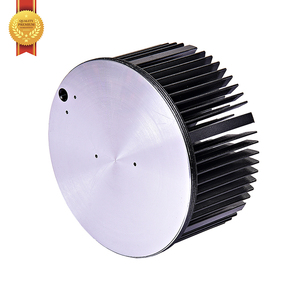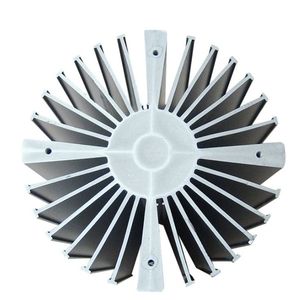(816 products available)









































































































































































































A 40mm heatsink is a component used to dissipate heat away from electronic devices, particularly around 40mm in size. Heatsinks come in various types and sizes, depending on their use and the amount of heat they need to dissipate. Here are some common types:
Square Heatsink:
This is the most basic type of heatsink and is found in many electronics. It dissipates heat efficiently and is cost-effective. It is used in applications where space is not limited, and the amount of heat is moderate.
Rectangular Heatsink:
This heatsink has a larger surface area than the square heatsink, which helps it dissipate more heat. It is used in applications where more cooling is required.
Active Heatsink:
Active heatsinks have fans that help move air over the heatsink and cooler the component more efficiently. The fans are powered by the computer or electronic device. Active heatsinks are commonly used in CPU and GPU cooling because they are very effective at dissipating heat.
Passive Heatsink:
Passive heatsinks do not have moving parts like fans. They rely on natural convection to dissipate heat. Because they do not have fans, passive heatsinks are quieter and use less power. They are used in laptops and other devices where low power consumption and quiet operation are more important than the amount of cooling.
Aluminum Heatsink:
Aluminum heatsinks are lightweight and less expensive than other heatsinks. They are made of aluminum, which dissipates heat well. Aluminum heatsinks are used in many devices because they are cost-effective and efficient at dissipating heat.
Copper Heatsink:
Copper heatsinks are more effective at dissipating heat than aluminum. Copper is more massive and more expensive than aluminum. These heatsinks are used in applications that require a small amount of heat to be dissipated quickly.
Extruded Heatsink:
These heatsinks are made by forcing aluminum through a mold to create long, thin pieces of metal with fins. The fins increase the surface area and help dissipate heat better. Extruded heatsinks are lightweight, cost-effective, and efficient at cooling.
Machined Heatsink:
Machined heatsinks are made by cutting and shaping solid blocks of aluminum or copper using machines. They can be made very precise and fit specific needs. These heatsinks are more expensive to produce, but they are used in applications that require very precise parts that can dissipate heat effectively.
When looking at the functions and features of a 40 mm heatsink, it is good to know the basic components that make it work properly.
Base Plate:
The base plate of a heatsink provides a solid foundation. It collects and spreads heat from components like CPUs and GPUs. The base plate transfers the heat to the fins for dissipation. It is usually made of aluminum or copper, which are good thermal conductors. The base plate is often flat or has a small dome to direct heat into the fins.
Heat Spreader:
The heat spreader is a part of the heatsink that evenly distributes heat across the entire surface. It ensures all areas are cooled uniformly. This prevents hot spots and over-heating of specific areas. It attaches to the component with thermal paste or adhesive.
Cooling Fins:
The cooling fins are long and thin extensions of the heatsink. They increase the surface area that releases heat into the air. The air flow over the fins cools them down, and in turn, cools the heatsink. Fins are usually made of aluminum or copper. The more fins there are, the more heat can be dissipated.
Fan:
When a fan is added to a heatsink, it greatly improves the cooling ability. The fan blows air over the cooling fins. This movement of air helps transfer more heat away from the heatsink and dissipate it into the surrounding area. In computers, the fan is an important part of keeping CPUs and GPUs at safe temperatures so they don't overheat.
Heat Pipes:
Some 40mm heatsinks use heat pipes instead of or in addition to fans. The heat pipes transfer heat very efficiently from hot parts to cooler areas. They use liquid that moves from heat-driven evaporation to cooler condensation to transport heat. This allows for more compact designs without relying solely on air movement like fans.
The 40mm heatsink is used in different applications. The good thing is that it can be adapted to work with different hardware components, depending on size and compatibility. Here are some scenarios where it is commonly used:
Cooling CPUs
Its primary purpose is to cool down the central processing unit. The 40mm CPU cooler reduces the risk of overheating. Moreover, it enhances the overall performance of the CPU. It is compatible with small form factor PCs. When building compact or small PCs, a 40mm CPU cooler is a good option. This is because it occupies less space than larger heatsinks or fans. Additionally, it is suitable for embedded systems and low-power CPUs.
Graphics Card Cooling
Another application for the 40mm heatsink is cooling the graphics card. It helps to maintain optimal temperatures for the GPU. Also, it enhances performance and prevents thermal throttling. It is compatible with small form factor graphics cards. The small heatsink is a good option for cooling small-sized graphics cards. Additionally, it is suitable for low-power GPUs. It can be used in systems with GPUs that consume less power.
Chipset Cooling
Chipsets are also cooled using 40mm heatsink. It helps to maintain optimal functioning and prevent overheating. Moreover, it is compatible with motherboards with limited space. The heatsink occupies less space than larger cooling solutions. Additionally, it is useful in systems with passive cooling. Here, the chipset relies on small fans and heatsinks for cooling.
Cooling Power Electronics
Power electronics are critical in different systems. This includes DC-DC converters, motor drivers and power amplifiers. A 40mm heatsink can be used to cool them. It dissipates heat effectively, ensuring optimal performance. Additionally, it prevents power electronics from overheating. This prevents potential failures and enhances their reliability.
Cooling LED Lights
LED lights are used widely in different applications. Prolonged usage can result in overheating. Fortunately, the 40mm heatsink dissipates heat effectively from LED lights. This ensures their optimal performance and longevity.
Apart from the factors mentioned above, there are several other factors business owners should consider when purchasing a 40mm heatsink in bulk. They include:
Application Requirements
Different electronic devices and applications have different cooling requirements. Business owners should consider the requirements of their intended applications and purchase heatsinks with varying sizes, designs and materials to meet those requirements.
Thermal Performance
Heatsinks are meant to dissipate heat from electronic components efficiently. Therefore, business owners should look for 40mm heatsinks with excellent thermal conductivity and performance. Such heatsinks are usually made of copper or aluminum.
Quality and Reliability
Another factor business owners should consider is the quality and reliability of the 40mm heatsink. They can check the manufacturer's certifications, reviews, and reputation to ensure they will receive quality products that will last and perform well.
Customization Options
If business owners are looking for something unique, they should consider 40mm heatsink suppliers who offer customization options. Such vendors will work with the clients to design and manufacture heatsinks that will meet their specific needs and requirements.
Lead Time and Delivery
Business owners should also consider the vendor's lead time and delivery schedule. If the vendor has a short lead time and reliable delivery, business owners will receive their orders on time and avoid inventory shortages.
Environmental Considerations
Business owners who are environmentally conscious can look for 40mm heatsink manufacturers who use sustainable practices. Such manufacturers will use eco-friendly materials and processes, which will reduce the overall environmental impact.
Q1: What is a heatsink 40mm?
A1: A 40mm heatsink is a cooling device with dimensions of 40mm x 40mm. It is usually used to cool components such as CPUs, GPUs, or power transistors. The heatsink dissipates heat by transferring it to the air, where it is dispersed.
Q2: What is a good heatsink?
A2: A good heatsink has good thermal conductivity and is durable. It also has good airflow and is compatible with the device it is intended to cool. A good heatsink will also have a low level of noise.
Q3: How is a heatsink measured?
A3: A heatsink is measured by its dimensions, which include its length, width, and height. Other measurements include thermal resistance, weight, and airflow. The heatsink is also measured in degrees Celsius per watt, which indicates its efficiency in cooling electronic components.
Q4: How is a 40mm heatsink ordered?
A4: A 40mm heatsink can be ordered from a supplier or manufacturer. The customer will have to specify the required specifications and any additional details, such as the quantity needed. Some suppliers also offer custom-made heatsinks.
Q5: What is a 40mm fan?
A5: A 40mm fan is a cooling device with a diameter of 40mm. It is used to provide airflow in electronic components to keep them cool. A 40mm fan is sometimes used together with a 40mm heatsink to cool CPUs and other components.